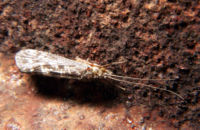
Photo from wikipedia
Abstract Sandy beaches are frequently visited for recreational purposes. Although such recreational activities are economically beneficial, they cause disturbances to these habitats. Every ecosystem has unique properties; thus, ecosystem-specific species… Click to show full abstract
Abstract Sandy beaches are frequently visited for recreational purposes. Although such recreational activities are economically beneficial, they cause disturbances to these habitats. Every ecosystem has unique properties; thus, ecosystem-specific species are often used as bioindicators of human disturbances. Here, we pioneer the use of an indirect burrow-counting technique on 20 sandy South Carolina beaches that experience different levels of human disturbance. Our results show that Ocypode quadrata (Atlantic Ghost Crab) is a reliable bioindicator of human disturbance on sandy beaches in South Carolina. The burrow density and width declined significantly as human disturbance increased. We also report that females outnumber males in highly disturbed sites. We conclude that the indirect burrow-counting technique employed in this study could minimize the cost and the effort of determining the human disturbances on coastal regions.
Journal Title: Southeastern Naturalist
Year Published: 2018
Link to full text (if available)
Share on Social Media: Sign Up to like & get
recommendations!